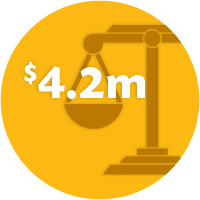It’s budget season again at HÂţ», which means the Budget Advisory Committee (BAC) has been busy planning for the upcoming year.
Last week, the BAC published its draft operating budget plan for 2014-15, as well as its recommendations for changes to student tuition and fees for next year. In the coming weeks, the Dal community has the opportunity to weigh in on the recommendations. (You can find consultation details at the bottom of this story.)
As we did last year, we’ve put together our “BACgrounder” on the draft budget plan, offering a look behind the numbers at the BAC’s recommendations and how they could impact the Dal community.
- Read:
- Read:
 Who is the Budget Advisory Committee?
Who is the Budget Advisory Committee?
The BAC advises the president on budgetary matters. It’s chaired by the Vice-President Academic and Provost Carolyn Watters and its membership includes two faculty members, one dean, the Vice-President Finance & Administration, one staff member and two students. Its members don’t serve as representatives of particular interests, but are chosen for their knowledge, expertise and experience.
You may notice that the BAC changed its process somewhat this year: rather than issuing a discussion paper in January, its members spent more time in the fall and winter terms engaging with Faculties, service units and student leaders ahead of developing recommendations. Faculties and service units were asked to respond to specific questions, and Deans were invited to present to the BAC to better inform the committee on particular concerns in their respective areas. The DSU, Libraries, Student Services and other groups, including Facilities Management and Finance, also made presentations to the BAC.
(Note: As was the case last year, this BAC report does not include the Agricultural Campus, which is currently funded under a separate agreement with the Province of Nova Scotia.)
 How Dal balances the budget
How Dal balances the budget
Dal’s Board of Governors requires that Dal’s budget be balanced, meaning any shortfall has to be made up either by finding more revenue or reducing expenditures. Last year’s operating budget was balanced with revenues and expenditures of $338.7 million.
Given that Dal’s operating grant is set by the province (see below), that leaves three options for addressing any shortfall in the budget: recruiting more students (a challenging and uncertain proposition to bank on), raising tuition fees, and finding savings through spending reductions.
 Government funding: A small increase
Government funding: A small increase
More than half of Dal’s budget (51.4%) comes from an operating grant from the Province of Nova Scotia. Over past three years, this funding has been cut by a combined 10%, meaning $16.6 million less for HÂţ»â€™s budget.
This year brings some modestly good news: the province is increasing funding by 1%, providing HÂţ» with an additional $1.6 million as compared to last year.
Why is this only modestly good news?
 Rising costs: Salaries, pension and more
Rising costs: Salaries, pension and more
The provincial funding increase is not nearly enough to address rising costs. Some of the cost pressures Dal faces:
- Salaries and benefits for faculty/staff: Compensation is the largest expenditure in the Dal budget (72.3%) and it increases each year as regular adjustments occur across all of Dal’s employee groups. In 2014-15, this means an estimated $7.4 million in increased costs for the university.
- Pension payments: The pension plays an integral part of compensation at Dal. Financial liabilities in Dal’s pension plan relating to increased life expectancy are estimated to result in an increase of $5.7 million in employer contributions in 2014-15. Fortunately, strong investment performance in the current year is helping to mitigate the effects somewhat but still will require the university to spend $2.7 million of next year’s operating budget in increased pension contributions.
- Other increases: As in other years, Dal is budgeting for cost increases in a number of other areas totaling approximately $2.1 million. Some examples:
- $857,000 in energy, water, tax and insurance expenditures
- $850,000 in operating costs for new buildings
- $125,000 to account for inflation in library acquisitions
- $582,000 to facilities renewal of existing facilities
- $367,000 towards supporting strategic priorities
With only $1.6 million in new funding from the government, HÂţ» needs to look to both tuition increases and cost savings to balance the budget.
 Tuition and Fees: A 3% increase for most programs
Tuition and Fees: A 3% increase for most programs
The government caps tuition increases in most programs at 3%. As was the case last year, the BAC is recommending HÂţ» raise tuition fees and the international differential fee by 3%, adding an additional $3.5 million to the budget.
The BAC is anticipating small growth in enrolment (50 students) for 2014-15, based on early applications, which would increase tuition revenue by about $265,000.
The BAC is also recommending Dal increase the auxiliary fee for facilities renewal by 3% (from $79.50 to $81.90 per term) to continue to upgrade existing facilities. There are other changes proposed to various auxiliary and ancillary fees, detailed in the , along with a short explanation of the reasoning behind each of the increases.
 Tuition and fees: Further increases in Medicine and Dentistry
Tuition and fees: Further increases in Medicine and Dentistry
The government’s tuition cap allows for larger tuition increases in select professional programs (Medicine, Law, Dentistry) and the international differential fee. The BAC carefully examined the relative costs of these programs across Canada on the premise that, given the high quality of the university’s offerings, Dal’s tuition for these programs should be comparable. It found that tuition fees in Medicine and Dentistry are average-to-low compared to other universities in Canada (7th of 13 in Medicine, 6th/7th of 8 in Dentistry, depending on if a student is from Nova Scotia or not).
Based on this analysis, the BAC is not suggesting additional increases in Law but it is recommending them in Medicine and Dentistry over a four year period — but only for new students starting this fall. The additional tuition increases are 2% in Medicine (for a total of 5%) and 6% in Dentistry (for a total of 9%). These phased tuition increases also place these programs more in line with tuition fees for other Dal undergraduate programs as compared with comparator universities.
Why only new students? During previous budget consultations, the BAC heard from students in professional programs that it was challenging to plan their finances when they could be subject to unexpected tuition increases in the future. Therefore, the BAC’s proposal is that the higher increases will be phased in, applying to new students entering the programs in Fall 2014 but not students currently in the programs.
The BAC did not recommend an additional fee increase for international students in this budget (beyond the same 3% as in all fees) while a further review is done.
Clearly, though, tuition increases alone can’t balance Dal’s budget, and budget cuts will be a crucial part of the equation as well.
 Cost savings: Budget reductions for Faculties, service units
Cost savings: Budget reductions for Faculties, service units
The BAC process doesn’t dive into the particulars of Faculty and service unit budgets. Instead, it recommends budget changes that are applied across the university, and it’s up to each budget unit — from Faculties like Science and Medicine through to units like Facilities Management, Student Services and Human Resources — to incorporate those changes in a way that best suits their individual needs.
Last year, all Faculties and service units were asked to find 3.5% in savings, but it’s not looking like this year’s cut will be as severe. Unlike in recent budgets, the BAC is recommending different reductions for Faculties and service units: a cut of 2.5% in Faculties and 1.25% in service units.
The BAC takes a number of factors into consideration when recommending differing levels of budget reductions. Some of these are that Faculties can gain revenue through an internal funding formula based on enrolment numbers (the ERBA, or “enrolment-related budget allocation”) and that Faculties often have greater potential for savings through retirement replacements than service units (due to salary scale differences between faculty and staff).
That said, one of the BAC’s go-forward recommendations is that the university review the criteria for budget reductions to provide more guidance in this area in the future.
 Surplus funds
Surplus funds
As has been the case in recent years, Dal’s enrolment growth is helping provide a cushion against deeper budget cuts. Last year, Dal set aside $6 million in surplus funds from higher-than-budgeted enrolment in previous years to balance the budget on a one-time basis. However, because Dal’s enrolment grew again last year, only $3 million of this was needed.
This year, surplus funds earmarked in the budget for one-time use are $4.2 million. The BAC acknowledges that using surplus funds only defers tougher decisions to the future, and recommends that the use of one-time funding be scaled back over the next several years because it’s not sustainable. For this year, however, the BAC is recommending the university use the $4.2 million to close the budget shortfall.
 Next steps: Your feedback
Next steps: Your feedback
Interested in providing your thoughts to the BAC before it makes its final recommendations to the president and, subsequently, the Board of Governors?
There are several ways you can do so:
- Students can email feedback to bac@dal.ca
- Faculty/staff can email their feedback to Linda Penny, director, budgets and financial analysis, at Linda.Penny@dal.ca
- Students are also invited to attend one of the upcoming consultations on tuition, fees and the budget. You’ll lean more about the budget and can ask questions to the Vice-President Academic and Provost Carolyn Watters, and Vice-President Finance and Administration (acting) Ian Nason.
All feedback will be collected and considered before the final recommendations are made to the Board of Governors in April.
--
Consultation information
Updated March 5
Medicine students
Tuesday, March 4
5-6 p.m.
Theatre A, Tupper Building and SJ102 in Saint John
Sexton campus
Tuesday, March 11
5:30-6:30 p.m.
Alumni Lounge
General session (DSU Council meeting + webcast)
Wednesday, March 12
6:30-7:30 p.m.
Room 303, Student Union Building (Also can be viewed in Room 138, Cox Institute, Agricultural Campus)
Dentistry students (rescheduled)
Thursday, March 13
5-6 p.m.
Room 4117, Dentistry Building
Webcast information for March 12 consultation
How to watch live
- Via BBLearn:
- On the DSU's YouTube channel:
Ask your questions
If you'd like to submit a question to be considered during the session:
- Email your question to bac@dal.ca
- Tweet your question using the hashtag #DalBudget
- Submit a question live through BBLearn during the session:
- Or, attend the session in person and ask your question there.
After the session
- The video of the council meeting will be archived at
- You can email further feedback on the tuition/fee recommendations and the BAC report to bac@dal.ca

